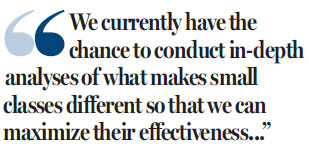Small classes in secondary schools benefit both students and teachers
Updated: 2016-07-26 07:28
By Gary Harfitt(HK Edition)
|
|||||||
The Hong Kong education authorities have been urged to embrace small-class teaching in secondary schools as a result of a falling student population. What was an issue in primary schools several years ago is now being discussed in the secondary sector. While class-size reduction (CSR) was researched, funded and then implemented at primary level in 2009, there has been no attempt by the government to investigate the merits of small-class teaching in our many secondary schools. There is an irony here, because a large number of those secondary schools have actually taken steps to introduce smaller classes in junior forms (Form 1-3) on their own accord without any official support. My aim here is not to call for a sweeping cut in class sizes. In my view CSR should only be carried out with a sound educational purpose in mind; it has to benefit teaching and learning first and foremost. However, with smaller classes emerging naturally as a result of demographic changes, aren't we missing a perfect opportunity to learn more about what makes small classes more efficient and how we can maximize them in future?
My own research into CSR in Hong Kong secondary schools informs me that small classes benefit students and teachers in multiple ways: qualitatively improved interaction between teachers and pupils; more free-flowing questions; more opportunities for group work and collaboration; a more personalized classroom curriculum; and reduced anxiety levels (in teachers and students).
I believe the government took the right decision in launching a small-class policy at primary level in 2009. Since then, there have also been ongoing evaluations and parallel professional development programs where teachers receive expert training on working with smaller classes. The formation of professional learning circles where teachers from different schools come together to co-plan lessons and observe one another teaching in small classes is one professional development model that offers much food for thought and I have seen first-hand how local primary teachers have benefited from this professional sharing and collaborative lesson planning. As a result of these initiatives, Hong Kong occupies a central position in class size research. Strangely, though, there has been no corresponding move to promote similar professional development models for secondary school teachers. The overwhelming majority of secondary teachers I have spoken to have been asked to teach small classes without any professional support or guidance from schools, or our education authorities. A common rebuttal to class size reduction is that teachers do not change their practices when moving from large to small classes, which is exactly why all small class initiatives must be accompanied by quality professional development programs.

So why is there hesitation from officials about investigating small-class teaching in secondary schools and promoting more focused professional development? A common response is that smaller classes are the norm from Form 4 when students choose their electives and begin the process of specialization. In other words, they are unnecessary. But what about the junior secondary years where the benefits of smaller classes may well be most significant in equipping younger learners with the knowledge and skills for later school years and, indeed, life outside of school? I am a fan of the New Senior Secondary (NSS) curriculum and its potential interface with the junior secondary forms. The NSS aspires to offer students a more flexible, diversified curriculum to cater better for learners' varied interests and capabilities and it places greater emphasis on preparation for lifelong learning through nine generic skills including creativity, critical thinking and collaboration. Crucially, the curriculum also places stress on nurturing honesty and open-mindedness in students. These are noble aims, but they require an accompanying pedagogical shift which might help to explain why so many secondary school managers have experimented with different class size arrangements; they recognize that smaller classes might help to provide teachers with enhanced opportunities to promote more critical thinking through a wider range of questions, cater for the increasing problem of learner diversity at all school levels and provide quality feedback in an interactive manner.
We currently have the chance to conduct in-depth analyses of what makes small classes different so that we can maximize their effectiveness for future generations of students and teachers. The case for this is especially strong given the move toward smaller classes in Hong Kong secondary schools right now. Such research and support can help school managers, practitioners, but most important of all, our students. At the same time, let's hone secondary school teachers' knowledge of appropriate pedagogies in small classes through tailored professional development initiatives which have been successful in the primary context. There is still so much for us to learn about small classes and how they work, because the potential benefits of CSR might be greater than we realize.
The author is an associate professor in the Faculty of Education at the University of Hong Kong.
(HK Edition 07/26/2016 page10)